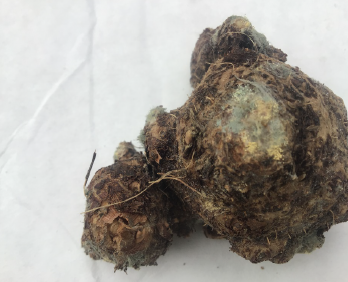Moldy Caladium Tubers

Occasionally we get calls regarding the receipt of moldy tubers. Though at first this appears to be a problem, in reality in most cases it is not a problem at all. Unlike many tubers, caladium tubers never go completely dormant and in fact maintain a rather high respiration rate. As you know respiration involves taking in oxygen (O2) and giving off carbon dioxide (CO2) and water (H2O). This results in a high relative humidity especially in a closed in environment, such as a shipping box. Caladium tubers also exfoliate, constantly shedding their outer epidermal layers. Combining dead epidermis with high humidity leads to saprophytic (non-pathogenic) mold growth on the surface of the tuber. The most common, widely occurring surface molds are the common bread molds (Aspergillus and/or Penicillium). Neither of these are plant pathogens.
To mitigate this Classic Caladiums waits until the last minute to close up shipping boxes and ship by the fastest means practical. Nevertheless, it is important to open the boxes as soon as you get them to get air to the tubers thus lowering humidity. As indicated above, caladium tubers, even dormant ones, have high respiration rates. Tubers experiencing temperature changes during shipping and at the customers greenhouse can actually get condensate on them further exacerbating the possibility of mold.
We hope you don’t experience mold on the caladium tubers you receive, however if you do don’t worry, just open the boxes immediately allowing air to reach the tubers and plant them as soon as possible.
More on Caladium Bulbs: Go Here